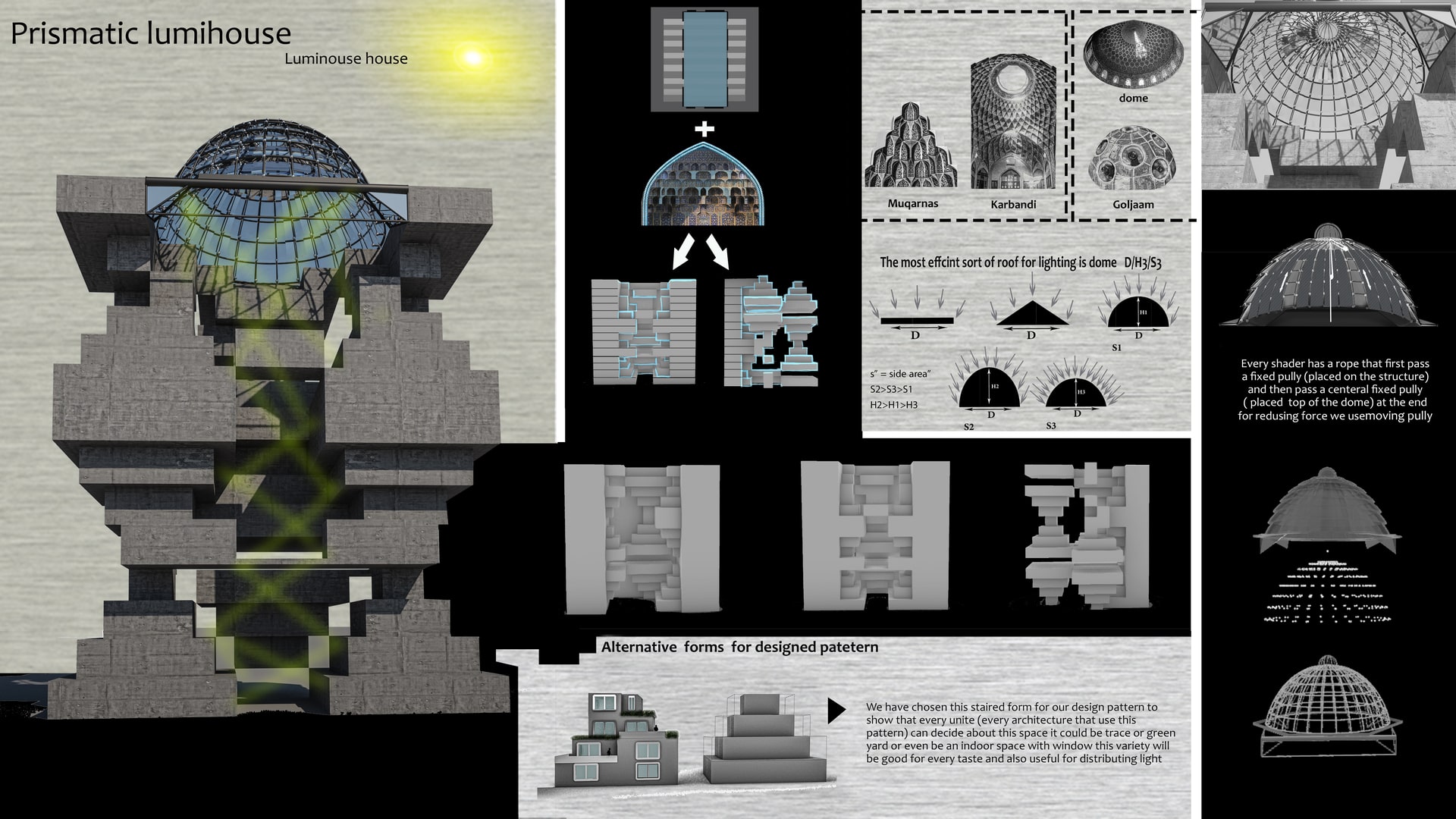Project Description
Problem Statement We decided to clarify these issues and then try to solve them during the design process: 1. Nowadays, buildings are turning into towers, and the area of units is minimizing. 2. Green spaces, middle yards, terraces, big windows are getting less because of the limitation of space and area, and density of units in that, so units do not get enough light. 3. Heat is a big deal if you want to use daylights, so ventilation is another issue because of these reasons; we decided to solve the problem of natural lighting in towers and tall buildings that have density and do not have a direct window to the outside. This issue is a challenge all across the world despite climates and culture, so we wanted to design a pattern to inter a light from the top of the buildings. Using specific tools and technics, we increase, distribute, and guide sunlight to cover buildings. Elements of Iranian Architecture: In our traditional architecture, we have many lighting elements. We have decided to study them and use the technics and concepts extracted from those of our heritage in our design. Tools, Technics, and Form: Appropriate tools and technics to increase, distribute, and guide the light should be capable of the ventilation and not cause blindness (cause by a height intensity of light) for users. We adopted tools like mirrors, optics, prisms also, we investigated best forms for our purpose. Tools: Prisms: Our research lead us to choose prisms because of their light distribution property. Prisms were used for lighting undergrounds and stores' showcases. Mirrors: We understood that mirrors could not be used a lot for their direct reflection can causes temporary blindness. Optics: We could not use convergent optic because of the heat energy they concentrate on a spot, but divergent optic would be used in full in our design product. Form and technics: As was said above, we wanted to light to enter from the top of the building, so the shape of the ceiling was crucial. As such, we experimented with different forms. The most critical factor was the area of the ceiling because if the area was vast, the entering light would increase. So, dome shape ceilings are better than other alternatives. Another reason to choose dome shape is that they distribute lights in every direction. (It was used for this function in traditional architecture). We also compared and calculated different dome-like oval dome or circle dome. In the end, we chose the “slow Hooloochin” arch to design dome because it is an oval dome, and that provides the maximum area, which is preferable. Still, along the elliptical base arch, we wanted to choose an arch that has less height because we did not wish to tarp the heat on its top, especially for the cold season, and for the hot season, we offered the use of a shader. Shaders are capable of opening and closing by fixed pulley and moving pulley mechanical system. We combine using prism and dome for distributing light also we consider the ventilation as well In conclusion, we designed a segmental dome by prisms, so to fulfill ventilation needs. That would happen because the pieces were arrayed in such a way that has a gap for ventilation by chimney effect and also does not let rain in, Another element that was used for traditional public bath for lighting called “Goljaam” is (made of glass) it fills the hole top of the dome to trap the heat and also distribute and increase the light. Our designed dome is inspired of Goljaam function and concept. We observe domes and vaults in spreading light we understand in addition to their structural or decorative roles architects use “Karbandi” and “Muqarnas” to spread light and guide it in every direction. Karbandiu is a geometric design of a masonry lattice space dome titled Karbandi in Persian architecture. Muqarnas is a type of corbel used for decoration in Islamic and Persian architecture. Karbandi and Muqarnas, besides their structural and decorative role, participate in distribution of light by segmenting domes or vaults in little pieces. Considering that, we decided to design the form of building inspired by Karbandi and Muqarnas so that we could spread the light all over the building. In reality, the fractures (stairs shapes) cause changing light direction and reflection. These reflections and distribution among dome and pieces of this building make the place brighter for everyone. We also used middle yards in upper floors to have more light and more green spaces for the users. About the yard, under the dome, we left one side open (or part of that side) to keep it functional in humid climates, but in drought climates, it is ok to close all sides and use it as a central yard.
